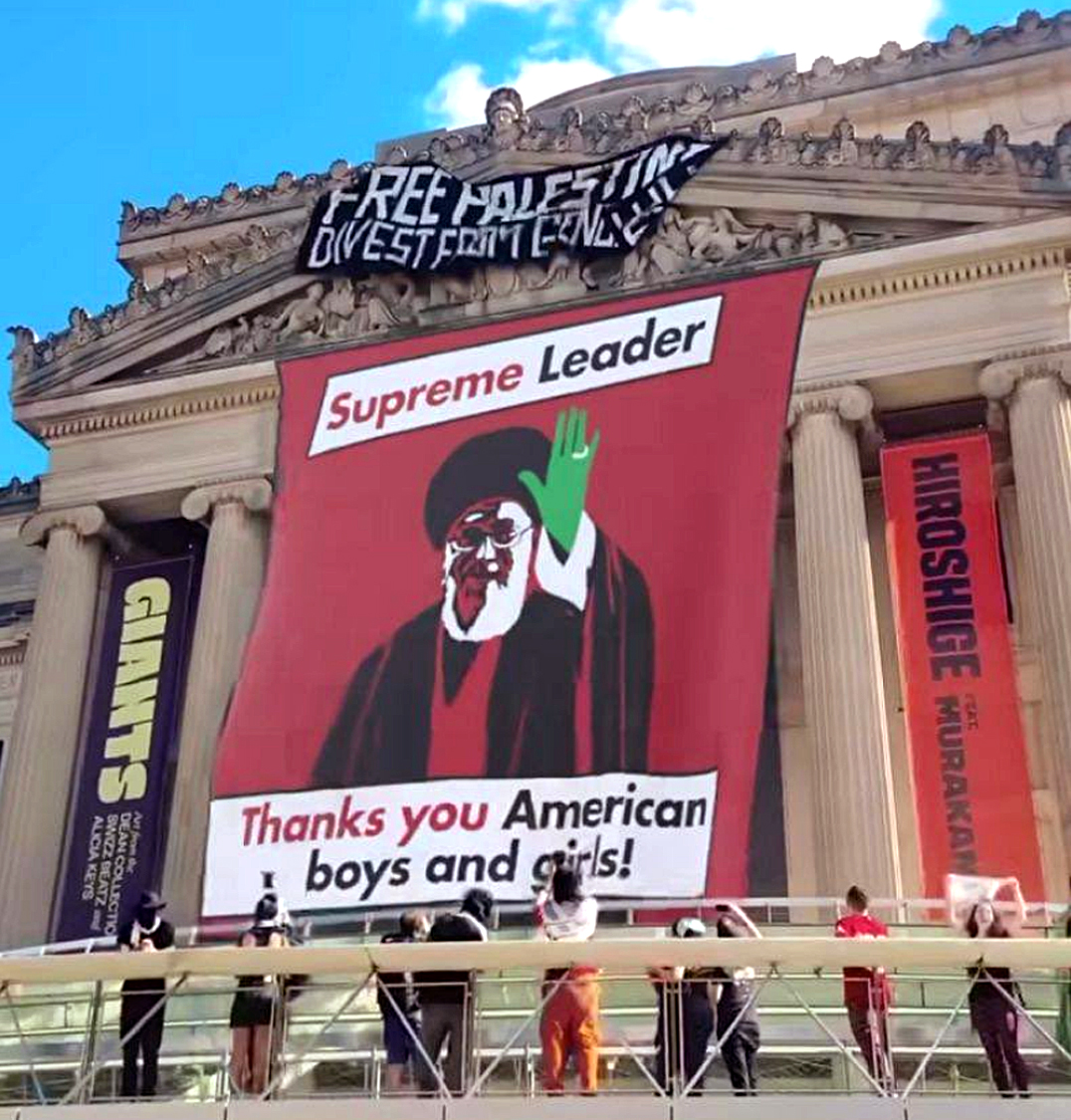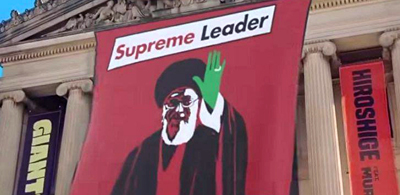The AI Ayatollah
I viewed a Telegram video on June 22, 2024 that showed militant anti-Israel protesters taking over the Brooklyn Museum in New York City on May 31, 2024. At the actual May demonstration, pro-Palestinian crowds seized the museum lobby and hung a gigantic black banner from the pediment over the entry way that read: “Free Palestine-Divest From Genocide.”
The June video on Telegram that showed the May event, recorded protesters unfurling a second colossal banner from the pediment. It was colored red, white, green, and black like the Palestinian flag, but it pictured the Supreme Leader of the Islamic Republic of Iran, Ayatollah Ali Khamenei. The text on the banner read: Supreme Leader Thanks you American boys and girls!
An anonymous video editor’s AI Ayatollah.
I stared at the Telegram video in disbelief as I thought out loud, “why didn’t I see this Supreme Leader banner before?” On June 1, 2024 I had published my blog post Pro-Palestine Protestors Seize Brooklyn Museum. I had scoured the internet for verified facts before publishing my article, but I never saw that Supreme Leader banner in my research. I became suspicious.
I went to X looking for the Supreme Leader banner and instead found a headline inserted in the Explore category. It read… AI-doctored video falsely shows Khamenei banner at Brooklyn Museum.
Numerous people had been fooled by the AI generated video. It’s terrifying that large numbers of people can be so easily deceived by a snippet of film. Now stop and think of how today’s 21st century media inundates us with non-stop torrents of images. Why do you trust those representations? I wouldn’t get too arrogant and braggish regarding those who were swindled by the Supreme Leader video.
There are lots of people in the arts that are worried about being displaced by AI generated works. This impacts, not only those of us who make paintings, prints, and drawings, but photographers, cinematographers, actors, writers, music composers, architects and many more. With AI the heads of all creative individuals are on the chopping block. But the wider implications of AI will be the intentional and unintentional skewing and shaping of public consciousness.

There is an interesting wrinkle in the tale of the AI Ayatollah that my dear wife brought to my attention when I showed her the Supreme Leader video. The first thing she said to me was: “Supreme is a clothing brand, whoever made the video copied the company’s logo.” To confirm her observation, I looked up the logo and indeed the “supreme” text in the video was an exact duplicate of the clothing brand logo. One of AI’s many jobs is to produce imagery, and the manner in which it placed the Supreme logo was just standard operating procedure for AI.
Here’s how AI works. A user types a prompt into an AI program requesting an artwork of a particular subject. The program excavates billions of images from the internet; paintings, prints, drawings, graphics, text, photos (copyrighted or not), and stores them as mathematical representations. It gathers all relevant numerical patters together, then remixes them to construct an image that responds to the prompt.
By compiling a rearrangement of what already exists, AI becomes the ultimate producer of “appropriation art.” For those of you untainted by the lunacies of today’s contemporary art establishment, appropriation art is its holy grail. Sane people have another word for it, plagiarism. Appropriation has robbed art of grandeur, virtuosity, and human spirit, sending it sinking into a trivial and utterly debased realm. Perhaps one day AI will take “art” a step further by administering a coup de grâce to humanity.
The Supreme brand was founded by American-British businessman James Jebbia in 1994. Someone gave Jebbia a book of artworks by postmodern conceptual artist Barbara Kruger, and lo and behold… the logo for Supreme was born! Jebbia had his graphic designer create the Supreme logo, lifting the design directly from Kruger’s signature style of a red box holding white letters set in Futura Bold Oblique type font. One guesses Kruger never sued Supreme for plagiarism because she had no copyright over the Supreme logo.
Here’s where that delicious contempt comes into play. I never liked Kruger’s feminist, anti-authoritarian, and anti-capitalist minimalist graphics—they struck me as disingenuous. Once her works were purchased by billionaires and were found in elite museums, my views were confirmed. How delicious that an anonymous video editor appropriated Kruger’s pipe dream aestheticism to inject a genuinely corrosive message into the bloodstream of “progressive” thought and action!

While the hoi polloi were howling and arguing about the authenticity of the Supreme Leader video released onto social media, countless others were using search engines to find out who the “Supreme Leader” character actually was. They found that the Supreme Leader of the Islamic Republic of Iran, Ayatollah Ali Khamenei, actually praised American students for holding pro-Palestinian campus uprisings. Supreme Leader Thanks you American boys and girls!
This is a victory the Situationist International couldn’t have imagined in the 1950s. I discovered the Situationists as a punk rocker in the late 1970s. Their ethos of creating situations from where there’s no turning back, was embodied by the early punk scene. For goodness’ sake, Malcolm McLaren, manager of the Sex Pistols was inspired by the Situationists.
As an artist I embraced Situationism, not for its spurious marxism but for its clear understanding of the modern “commodity-spectacle society.” Mavens in today’s art world pretend Situationism is the root of their curseworthy performance, conceptual, installation, and appropriation art. But the truths of Situationism were turned upside-down by art elites. Even so, the Situationist spirit was reborn when that unknown video editor trollishly released a videographic that cut through the daily presented spectacle to uncover reality.
From 1967 the voice of Belgian Situationist Raoul Vaneigem rises from the void with some apropos words: “Everywhere the same law holds good. There is no weapon of your individual will which, once appropriated by others, does not turn against you.”

On May 25, 2024, the Supreme Leader of the Islamic Republic of Iran, Ayatollah Ali Khamenei, released a letter specifically addressed to American university students protesting against Israel. The statement applauded students seizing campuses to build barricaded “Free Gaza” tent cities. The Ayatollah wrote:
“I am writing this letter to the young people whose awakened conscience has moved them to defend the oppressed women and children of Gaza.
Dear university students in the United States of America, this message is an expression of our empathy and solidarity with you. As the page of history is turning, you are standing on the right side of it. You have now formed a branch of the Resistance Front and have begun an honorable struggle in the face of your government’s ruthless pressure-a government which openly supports the usurper and brutal Zionist regime.
Besides you students from dozens of American universities, there have also been uprisings in other countries among academics and the general public. The support and solidarity of your professors is a significant and consequential development. This can offer some measure of comfort in the face of your government’s police brutality and the pressures it is exerting on you. I too am among those who empathize with you young people, and value your perseverance.”
The Ayatollah’s letter is long and filled with lies, which is expected from a sworn enemy of the United States. His fundamentalist Islamic regime squashes dissent and employs “morality police” to punish women who violate the hijab dress code. Regardless, he does empathize with young Americans who have “formed a branch of the Resistance Front.” And since the Ayatollah is a defender of the Palestinian people, it’s a certainty all keffiyeh wearing American boys and girls have high regard for him as well.
Here’s something that should be mentioned in closing. In 1923 Pablo Picasso gave an interview to a monthly New York periodical known as The Arts. His words from that conversation have long been misunderstood. Perhaps the context of this essay will bring some clarity to Picasso’s colloquy:
“We all know that art is not truth. Art is a lie that makes us realize truth.”


